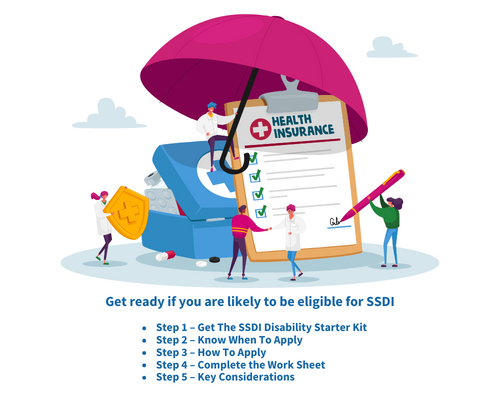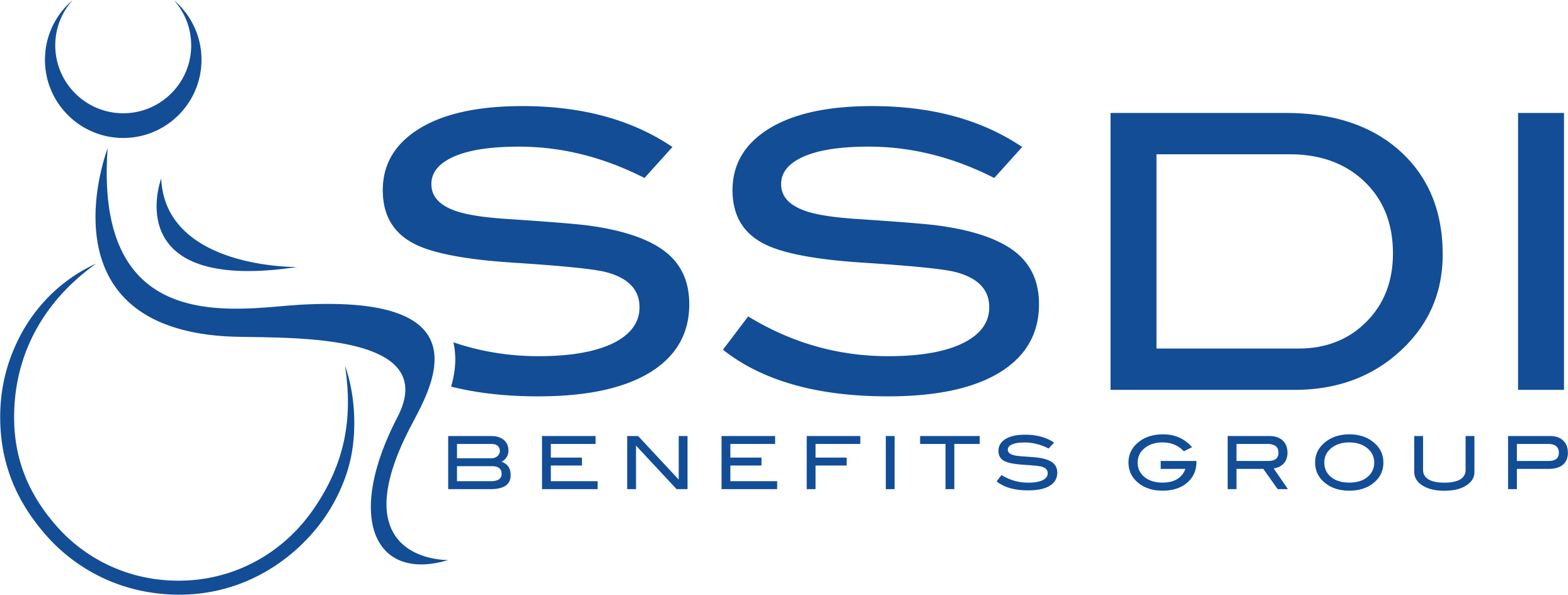SSDI Benefits Application Checklist
You can be eligible for Social Security Disability Insurance (SSDI) if a long-term disability prevents you from working. However, you must go through the Social Security Administration (SSA) application process, which requires supplying a significant amount of information, before you can start collecting benefits.

WHAT YOU SHOULD KNOW BEFORE YOU APPLY FOR SSDI BENEFITS
Get ready if you are likely to be eligible for SSDI
We are aware of the importance of these benefits in your circumstance and the high rate of application denials by the SSA. We aim to guide you through this procedure effectively. To help you apply for SSDI benefits, we have put up an application checklist, Steps with important tips, and a list of required documents.
Step 1 - Get The SSDI Disability Starter Kit
The first step after deciding to apply for Social Security Disability is to receive and completely review the SSDI Adult Disability Starter Kit. This kit contains a factsheet with a definition of disability, a checklist of essential papers, and a worksheet to assist you in preparing for your disability assessment interview or filling out the SSDI Disability Application.
Step 2 - Know When To Apply
If you expect to be unable to work for a year or more, or if you have a terminal illness, it is critical that you file a Social Security Disability claim as soon as possible. Begin planning as soon as you are disabled because as per law disability benefits do not begin until the sixth full month of disability. The waiting period begins the first full month following the Social Security Administration’s determination of the start date of your disability.
To be declared impaired by Social Security, you must be unable to engage in any substantial gainful activity due to your medical condition. Furthermore, your medical condition must have lasted or been projected to last at least one year, or it must be predicted to end in your death.
Step 3 - How To Apply
The SSA has put in place a number of application processes to guarantee that the SSDI program is widely accessible. You have the choice to apply for SSDI benefits in person by making an appointment to go to the SSA office. As an alternative, you can submit a Social Security Benefit Application online. You can also apply over the phone by dialing the toll-free number 1-800-772-1213, Monday through Friday from 7 a.m. to 7 p.m. EST if you feel more comfortable doing so. The required information and documentation are pretty much the same in every situation, however, filling it out online will speed up the Interview process.
SSDI Benefits Application Checklist
You can use the information provided here to assist you collect the data you might need to set up a “My Social Security account” and finish the online Disability application. To apply online, you must first create a “My Social Security Account.” You will be asked a variety of personal identification questions during the setup process, including information from your W-2 form, tax returns, cellphone number, and credit card.
The Information You Need To File for SSDI Benefits
1) Date and Place of Birth — If you were born outside the United States or its territories:
• Name of your birth country at the time of your birth (it may have a different name now)
• Permanent Resident Card number (if you are not a U.S. citizen)
2) Marriage and Divorce — Name of current spouse, name of prior spouse (if the marriage lasted more than 10 years or ended in death)
• Spouse(s) date of birth and Social Security number (optional)
• Beginning and ending dates of marriage(s), place of marriage(s) (city, state or country, if married outside the U.S.)
3) Names and Dates of Birth of Children Who— Became disabled prior to age 22, or
• Are under the age of 18 and are unmarried, or
• Are aged 18 to 19 and still attending secondary school full time
4)Employer Details for Current Year and Prior 2 Years (not self-employment)—
• Employer name, employment start, and end dates, total earnings (wages, tips, etc.)
5)Self-Employment Details for the Current Year and the Prior 2 Years—
• Business type and total net income
6)Direct Bank Deposit info—
• Account type and number
• Bank routing number
7) Alternate Contact—
• Name, location, and phone number of a person we may contact who is familiar with your medical condition(s) and can assist you with your claim.
8) Information About Doctors, Healthcare Professionals, Hospitals, and Clinics—
• Names, addresses, phone numbers, patient ID numbers, and dates of examinations and treatments
• Names and dates of medical tests you have had and who sent you for them
• Names of medications (prescriptions and non-prescription), reason for medication, and who prescribed them.
9)Information About Other Medical Records—
• Vocational rehabilitation services, workers’ compensation, public welfare, prison/jail, an attorney, or another place
10)Job History—
• Date your medical condition began to affect your ability to work
• Type of jobs (up to 5) that you had in the 15 years before you became unable to work because of your condition
• Type of duties you did on the longest job you had
11)Education and Training—
• Highest grade in school completed (date), and any special education (school name, city, and state)
• Name of special job training, trade school, or vocational school and date completed
The Information You Need for the Interview
A Social Security official will interview you in order to complete an application for disability benefits as well as an Adult Disability Report. The interview can take place in person at your local Social Security office or over the phone for at least one hour. You can cut your interview time in half if you start the procedure online. Both the benefits application and the disability report can be done online.
Even if you begin the procedure online, you must still attend your scheduled appointment at your local Social Security office. A representative will review your information during this consultation. If you are unable to transact business online, please complete the included Medical and Job Worksheet and bring it with you to your appointment. Bring the information on the included checklist to your office visit to streamline the process even more. If you have a phone appointment, the representative may ask you to provide any required checklist items.
Step 4 - Complete the Work Sheet
Fill out the medical and job worksheets included in your beginning kit. The worksheet will allow you to prepare for your interview and have all of the information at your fingertips.
Step 5 - Key Considerations
Simply having your doctor declare you disabled does not entitle you to disability compensation. It is critical that you are prepared to provide extensive explanations of why you are unable to work and how your debilitating condition has affected your everyday activities.
The definition of disability is strict under Social Security law. Two conditions must be met in order to be termed disabled:
- Because of your medical condition(s), you must be unable to conduct any substantial work.
- Your medical condition(s) must have continued for at least one year or be predicted to result in your death.
In addition to meeting Social Security’s criteria for disability, you must have worked and paid to the program for at least five of the last 10 years to be eligible for Social Security Disability benefits (SSDI).
Be well-prepared if you suspect you may be eligible for SSDI. Keep in mind that obtaining SSDI benefits is not a simple process; it necessitates a strong case formulation as well as the gathering of all relevant documents and evidence to support your claim. If you find the process too difficult, consider hiring a disability representative like us from the beginning of your SSDI application. Without guidance, your initial application may be denied, and the appeals procedure may be lengthy. Fill out our online disability evaluation form to get your disability claim examined for free. Working with an attorney could potentially save you the time and effort of going through the appeals process, allowing you to receive the benefits you are entitled to sooner.
HOW CAN WE HELP YOU?
Need help
applying?
The biggest mistake individuals make is thinking it’s a good idea to handle SSDI claims themselves. Qualifying SSDI is complicated and shouldn’t be brushed off.
Recently
Denied?
It’s not easy to get approved for SSDI benefits, Around 65% of first SSDI applications are turned down. We Have helped many applicants qualify who were previously denied.
Am I
Eligible?
If you are unable to work due to injury or illness, SSDI might be the appropriate option for you. Begin your free evaluation now to determine if you qualify!
